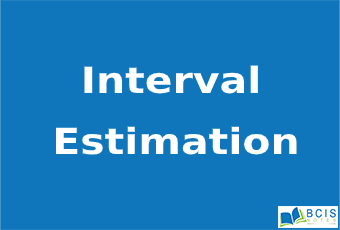
Interval Estimation
Point estimation is a single value of a parameter. In many cases single point may not be realistic to estimate the parameter then it will be more appropriate to estimate the parameter in an interval that includes the true value of the parameter with a certain degree of confidence. This degree of confidence is always measured in terms of probability. This method of obtaining such an interval is called interval estimation and such interval is known as the confidence interval.
Given a random sample of ‘n’ independent value x1, x2,… ….xn of a variable x having the probability density function f(x,θ); θ being the parameter. We wish to find a and b, the function of x1, x2,… ….xn such that we assort with a certain degree of confidence (in the probability sense) i.e. P (a ≤ θ ≤ ) = 1 – α, where a is lower confidence limit and b is upper confidence limit. 1 – α is called the confidence level or confidence coefficient.
Confidence interval estimate of the population mean from the large sample:
Let µ be the population means and X̅ be the sample mean of the sampling distribution of means. It is also assumed that the sample mean is normal if the sample is large. Then the interval estimate of the population means µ by the sample mean X̅ of the sampling distribution of means is given by the following relation.
Confidence interval = [X̅ Zα S.E.(X̅)] = [X̅ Zα ] = [X̅ Zα , X̅ Zα ]
Where,
Zα = value of Z at the α level of significance
S.E.(X̅) = standard error of the sample mean = [if the population is large or infinite and sample are drawn with replacement]
N = population size
n = sample size
σ = population standard deviation
If σ is not given we estimate ‘σ’ from sample standard deviations ‘s’.
Note: In case of simple random sampling without replacement from a finite population size N, then interval estimate of a population mean µ is given by
Confidence interval = [X̅ Zα S.E.(X̅)] = [X̅ Zα ]
The following table gives a common confidence level and their Z values
| Confidence level (1 – α) | 50% | 68.26% | 90% | 95% | 96% | 98% | 99% | 99.73% |
| Zα | 0.6745 | 1 | 1.645 | 1.96 | 2.05 | 2.33 | 2.575 | 3 |
Note: When no reference to the confidence level is given, then always take Zα = 3
Confidence limits for a population proportion
Let p be the sample proportion of success and P be the corresponding population proportion then,
Confidence interval = [p Zα S.E.(p)] = [p Zα S.E.(p), p Zα S.E.(p)]
Where,
S.E. (p) = if the population is finite or large and samples are drawn with replacement
S.E. (p) =, if P and Q are not given
S.E. (p) =, if the population is finite or large and samples are drawn without replacement
S.E. (p) =, if P and Q are not given
You may also like: Estimation & its characteristics || Estimation & Hypothesis

Leave a Reply